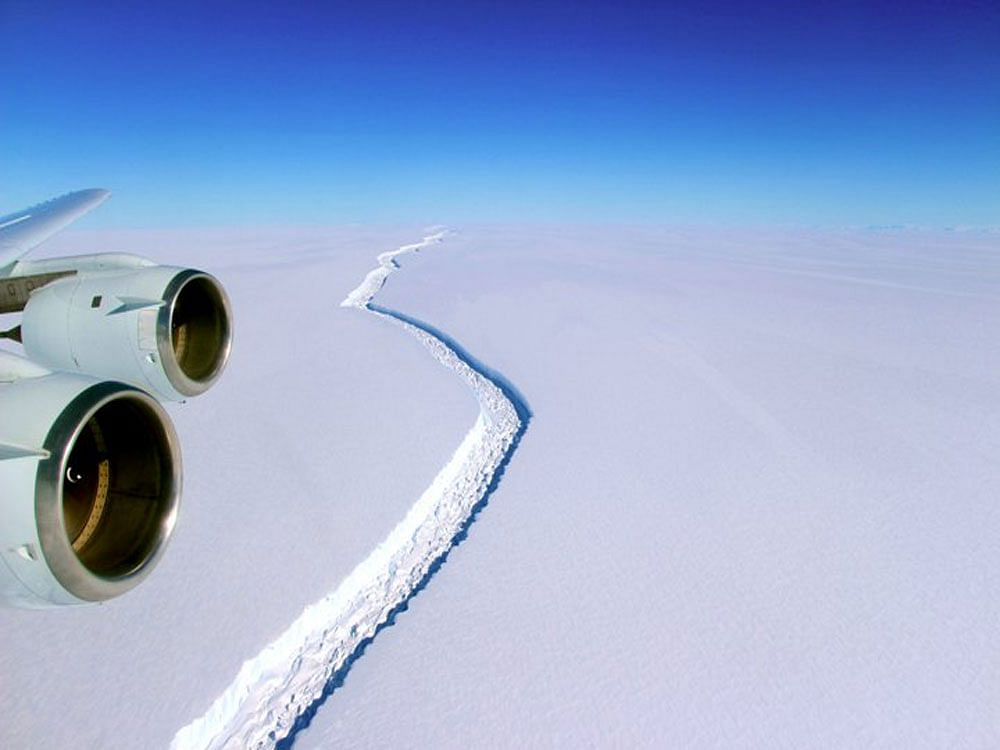Huge iceberg poised to break off from Antarctic ice shelf
Last Updated IST

The Larcen C ice shelf is cracking at a rapid pace and is poised to become of the biggest icebergs in history. Photo credit: twitter.
A huge crack in the Antarctic ice shelf - poised to produce one of the largest icebergs at the South Pole - is growing faster than ever, with the rift tip now within five kilometres of breaking all the way through, scientists say.
The deep crack in the Antarctica's Larsen C ice shelf continues to cut across the ice. While the iceberg remains attached to the ice shelf, its outer end is moving at the highest speed ever recorded on this ice shelf.
It has tripled in speed to more than ten metres per day between June 24 and 27, according to scientists of Project MIDAS, a UK-based Antarctic research project. When it eventually gives way, one of the largest icebergs on record will be set adrift.
Monitored by the Copernicus Sentinel-1 radar pair, the crack in the ice is now around 200 kilometres (km) long, leaving just five km between the end of the fissure and the ocean.
European Space Agency's (ESA) CryoSat Earth Explorer satellite carries a radar altimeter that will measure the height of the ice surface before the 6,000 square kilometre iceberg is spawned.
The information is used to work out how the thickness of sea ice and land ice is changing and, consequently, how the volume of Earth's ice is being affected by the climate.
"Using information from CryoSat, we have mapped the elevation of the ice above the ocean and worked out that the eventual iceberg will be about 190 metres thick and contain about 1,155 cubic kilometres of ice," said Noel Gourmelen from the University of Edinburgh in the UK.
"We have also estimated that the depth below sea level could be as much as 210 metres," Gourmelen said.
Icebergs calve from Antarctica all the time, but because this one is particularly large, its path across the ocean needs to be monitored as it could pose a hazard to maritime traffic.
An iceberg, similar in size, drifted around the Brunt ice shelf in December 2015, causing alarm for those stationed at the Halley research base, which sits on the floating section of the shelf.
"Measurements from CryoSat showed that the Brunt berg was around 390 metres, so too thick to come close to 'shore' since the sea is shallow here," said Anna Hogg from the University of Leeds in the UK.
"As for this new Larsen C berg, we are not sure what will happen. It could, in fact, even calve in pieces or break up shortly after," Hogg said.
"Whole or in pieces, ocean currents could drag it north, even as far as the Falkland Islands. If so it could pose a hazard for ships in Drake Passage," she said.
The deep crack in the Antarctica's Larsen C ice shelf continues to cut across the ice. While the iceberg remains attached to the ice shelf, its outer end is moving at the highest speed ever recorded on this ice shelf.
It has tripled in speed to more than ten metres per day between June 24 and 27, according to scientists of Project MIDAS, a UK-based Antarctic research project. When it eventually gives way, one of the largest icebergs on record will be set adrift.
Monitored by the Copernicus Sentinel-1 radar pair, the crack in the ice is now around 200 kilometres (km) long, leaving just five km between the end of the fissure and the ocean.
European Space Agency's (ESA) CryoSat Earth Explorer satellite carries a radar altimeter that will measure the height of the ice surface before the 6,000 square kilometre iceberg is spawned.
The information is used to work out how the thickness of sea ice and land ice is changing and, consequently, how the volume of Earth's ice is being affected by the climate.
"Using information from CryoSat, we have mapped the elevation of the ice above the ocean and worked out that the eventual iceberg will be about 190 metres thick and contain about 1,155 cubic kilometres of ice," said Noel Gourmelen from the University of Edinburgh in the UK.
"We have also estimated that the depth below sea level could be as much as 210 metres," Gourmelen said.
Icebergs calve from Antarctica all the time, but because this one is particularly large, its path across the ocean needs to be monitored as it could pose a hazard to maritime traffic.
An iceberg, similar in size, drifted around the Brunt ice shelf in December 2015, causing alarm for those stationed at the Halley research base, which sits on the floating section of the shelf.
"Measurements from CryoSat showed that the Brunt berg was around 390 metres, so too thick to come close to 'shore' since the sea is shallow here," said Anna Hogg from the University of Leeds in the UK.
"As for this new Larsen C berg, we are not sure what will happen. It could, in fact, even calve in pieces or break up shortly after," Hogg said.
"Whole or in pieces, ocean currents could drag it north, even as far as the Falkland Islands. If so it could pose a hazard for ships in Drake Passage," she said.